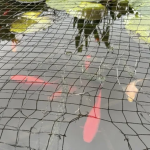On workplace wellbeing
Yesterday evening, my nine-year-old dog, Poppy, required a small surgery to stitch up a deep surface wound. It turns out our park hawthorn bushes are sharper than anticipated – she caught her back while running after her precious tennis ball.
Once the treatment was agreed upon, I felt a bit lighter and noticed the pond full of fish at the entrance to the emergency clinic. The little pond was full of lovely little common goldfish and a few koi fish too. Some were larger than others, but all of them perfectly matched the size of the pond. We have two small fish tanks at home, so I know that those animals usually grow to the size of the tank – Nature is wise.
This little pond was a fantastic metaphor for workplace well-being. Some fish are smaller, others a bit larger, but all fish intuitively remain at a size that allows thriving homeostasis in their environment.
Let’s imagine the tank is a company. So, I wondered, what happens when one fish decides to grow way beyond the reasonable size? Due to the lack of space in the tank, others will need to shrink themselves simply to fit in to survive. And suddenly, one living being in an advantageous position disrupts the balance – it thrives while others suffer.
In the UK, the counselling provision (IAPTus) emerged from a commonly known “Five Ways to Wellbeing” report commissioned by the UK Government from the NEF Foundation in 2018. The report was commissioned to identify only individual factors improving well-being (connect, stay active, take notice, keep learning, give), so NEF (wisely!) included additional recommendations also featuring the systemic factors identified during the research: well-being at work, nutrition and Nature.
Major mental health organisations now support workplace well-being by providing training and guidance on the topic—our rights at work, our psychological safety and our well-being at work matters. We spend so much time at work! In fact, I personally dislike the term “work-life balance” because if our work is healthy and nurturing, it becomes an integral part of our lives.
But what happens when the workplace is not safe? What if some people benefit from support while others feel there’s not enough space for their authentic selves and end up code-switching, squeezing themselves into impossible moulds and ending up seriously unwell? What if our workplace feels like walking the path of Alice in Wonderland? We see it all around us: workplaces with high employee turnover hire new people all the time for the same roles while the remaining staff suffer and sign off on compassionate or sick leave to restore. Tiny ponds with oversized fish. It’s unnatural.
So I am often asked: what is technology’s role in those distorted landscapes?
First of all, the new, socially connected platforms allow more freedom of voice for individuals to flag problems and ask for change internally. You can email your HR, check in with a colleague, and even reach out to your Board if needed. It doesn’t always work and sometimes needs amplifying collectively, but it is at least possible.
Secondly, how we share on social platforms captures timing, which is critical in initiating and supporting change for the better. Who says what when is telling and unveiling. Who remains silent or is actively silencing becomes documented, and you can see it immediately.
There are multiple ways of showing allyship through digital tools with people who struggle: you can show your support openly (only if it’s safe for you to do so) by liking posts or commenting – do not underestimate the power of a simple like. You can share your experience if you feel the same way. And if you do not feel safe to do so, you can send a private message of support —every single one of those matters. It takes a village to make genuine changes happen.
Companies do not operate in a vacuum. There is an ecosystem of messages and profiles outside of the organisation. You can reach out to people outside of the organisation for support and collective holding, especially those who left and may understand what you are going through. You can often notice signs of dysfunctional companies simply by reading other people’s social media posts – it’s pretty obvious when people are unwell.
You can research best practices in workplace well-being, your employment rights and relevant organisations you can reach out to for support. And finally: you can seek mental health support through online therapy too.
I am often also asked by leaders how to avoid a PR crisis.
My answer is short: don’t generate it. Care for your teams, and be fair and kind.
And if something does happen – maybe a new team member didn’t get the kindness memo – first and foremost: say sorry. Apologise from the most senior place possible in your organisation. Believe the person talking so others can trust you in the future. Investigate (not the nicest of words, but at least it means you take it seriously) the full situation. Report back to all – transparently. Explain how you will do better and do that. Actually, follow through. Nothing is more trustworthy than a leader who fails, apologises and grows wiser from it.
As for digital technologies – do not use PR teams, but ask your social media team. The two types of communication styles are very different: PR is about making people believe your version of events – internally, this just doesn’t work. Social media is about listening to what others say and responding with integrity, and that’s the communication style you need to engage in a real dialogue.
I also advise my clients in senior roles to read Margaret Heffernan, Simon Sinek and Howard Shulz (for a start). You don’t need to know everything, but you are expected to admit it and do better. You may be a bigger fish, but you are still expected to keep your teams safe and well. You are the guardian of the company’s homeostasis. Additionally, please remember there’s always a bigger fish. That’s just how life works. In my experience, the bigger the pond, the wiser the big fish – as they experience this truth more often. It may be helpful to consider all your staff as one big school of fish. You would be lost and alone without them.
–
Regardless of your position of power, you have more tools to exercise your influence in the digitally connected world than ever before. It really is a question of developing our self-awareness. Maybe, just maybe, it is actually not only about the fish but also about water:
(Reflection)
Thinking about our role in workplace well-being is important. Increasing our awareness about our individual needs and expectations for good mental health at work is a great start to raising the bar for collective standards.
Q: What do you need from your employer and your workplace to feel safe to be authentically your whole self at work? What do you need to feel included, considered, actively protected and nurtured? What gets in the way? What needs to change? What is not changing? Where else can you find help? Is this workplace good enough to nurture your well-being? If you fancy a creative exercise, use my metaphor: if your workplace was a pond, describe the water, the fish and everything else in it and then do the same for your ideal workplace. Maybe even note down what needs to change.
(On this note, I shall go and top up the water in our fish tanks. Have a light Sunday!)
This post was originally posted on Substack in our Syl’s Liberation Psychologies Newsletter.

